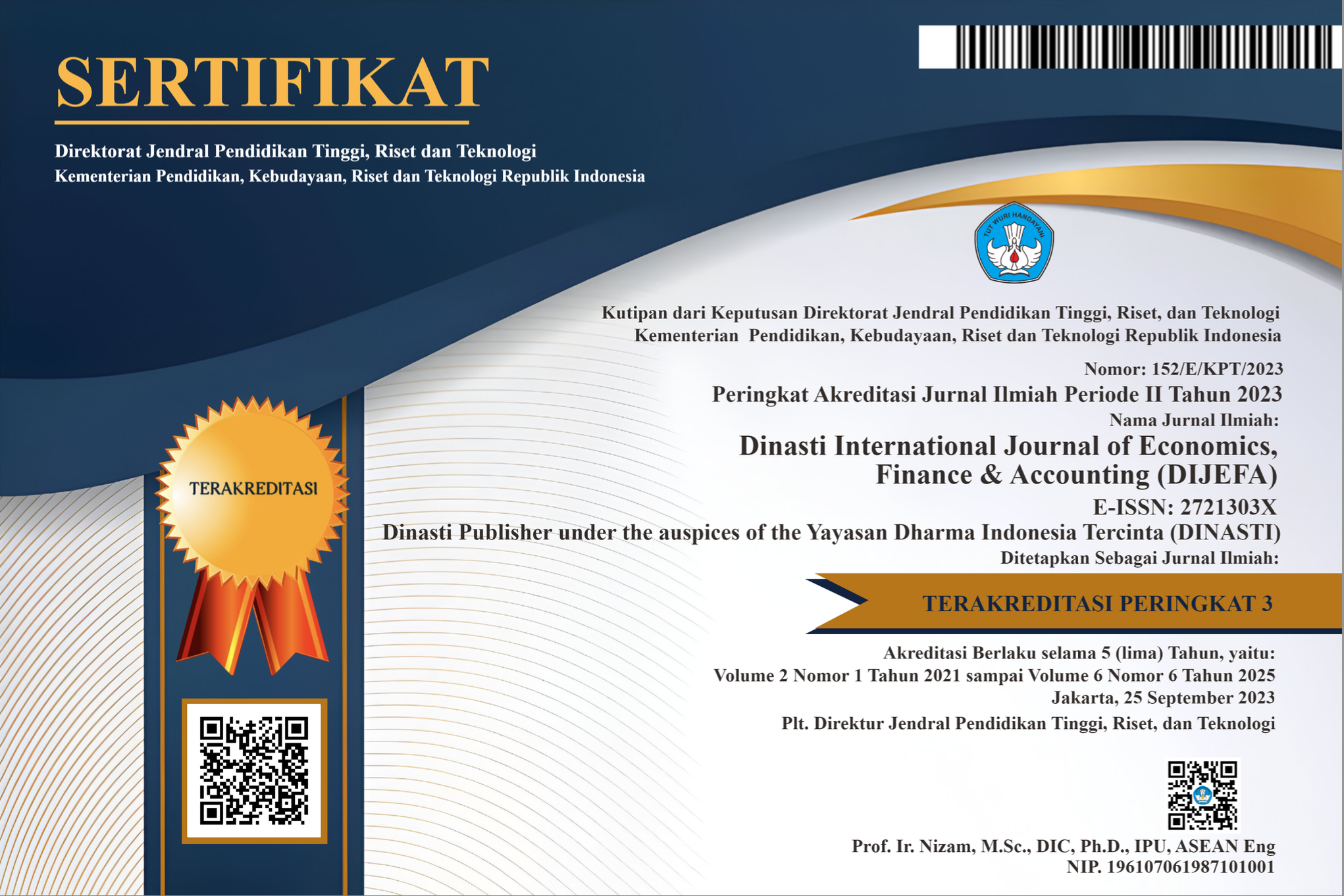Empirical Analysis of Stock Markets That Are More Prone To Losses: A Standard Coverage Test Approach
DOI:
https://doi.org/10.38035/dijefa.v4i3.1924Keywords:
Stock Market Losses; Standard Coverage Test, Stock Markets; Diversification; Risk ManagementAbstract
Stock market losses have been a recurring phenomenon in financial markets with far reaching implications for investors as it directly impacts the value of their portfolios and potentially jeopardizing retirement savings leading to a loss of income. Identifying stock markets that may realise less returns on investments has been critical area for portfolio managers and active market participants. Therefore, the aim of this study was to empirically investigate financial markets that are prone to losses in order to safeguard and protect investments. A standard coverage test analysis was applied in five selected markets for a sample period from June 7, 2018 to June 7, 2023. This coverage test was used to identify stock markets that breached their generalised indicators and expected losses. The findings revealed that stock market losses are significantly higher in the CAC 40 and Nikkei 225. This was evident in the significant risk violations from their expected levels. By implication, investors willing to invest in the CAC 40 and Nikkei 225 are advised to use sector diversification strategies, stop-loss orders and long term investment strategy to mitigate some of these losses.
References
Baek, S., Mohanty, S.K., & Glambosky, M. (2020). COVID-19 and stock market volatility: An industry level analysis. Finance Research Letters, 37, 1-10.
Berouaga, Y., El Msiyah, C., & Madkour, J. (2023). Portfolio Optimization Using Minimum Spanning Tree Model in the Moroccan Stock Exchange Market. International Journal of Financial Studies, 11(2), 53.
Chaudhary, R., Bakhshi, P., & Gupta, H. (2020). Volatility in International Stock Markets: An Empirical Study during COVID-19. Journal of Risk and Financial Management, 13(9), 208.
Engle, R.F. & Campos-Martins, S. (2023). What are the events that shake our world? Measuring and hedging global COVOL. Journal of Financial Economics, 147, 221-242.
Enow, S.T. (2022). Overreaction and underreaction during the covid-19 pandemic in the south African stock market and its implications. Eurasian Journal of Business and Management, 10(1), 19-26.
Enow, S. T. (2023). Forecasting volatility in international financial markets. International Journal of Research in Business and Social Science, 12(2), 197-203.
Enow, S.T. (2023). Investigating Causality and Market Contagion During Periods of Financial Distress and Its Implications. Journal of Accounting, Finance and Auditing studies, 9(1), 140-153.
Haroon, O., & Rizvi, S.A.R. (2020). COVID-19: media coverage and financial markets behavior—A sectoral inquiry. J. Behav. Exp. Finance, 27, 100343.
Ha, J., & So, I. (2023). Global Confidence, Uncertainty, and Business Cycles. International Journal of Central Banking,19(1), 451-495.
Kupiec, P. (1995). Techniques for verifying the accuracy of risk measurement models. Journal of Derivatives, 3, 73–84.
Lee, M.C., Chang, J.W., Yeh, S.C., Chia, T.L., Liao, J.S., & Chen, X.M. (2022). Applying attention-based BiLSTM and technical indicators in the design and performance analysis of stock trading strategies. Neural Comput & Applic, 34, 13267–13279.
Raffestin, L. (2014). Diversification and systemic risk. Journal of Banking & Finance, 46(1), 1-57.
Samimi A, & Samimi M. (2021). Investigating the Strategic Concept of Risk Management in the Stock Market and Investing. JEIR, 2(1), 1-6.
Singh, S., & Chakraborty, A. (2016). Stock Price Movement through Technical Analysis: Empirical Evidence from the Information Technology (IT) Sector. IRA-International Journal of Management & Social Sciences, 3(1), 141-148.
Downloads
Published
How to Cite
Issue
Section
License
Authors who publish their manuscripts in this journal agree to the following conditions:
- The copyright on each article belongs to the author(s).
- The author acknowledges that the Dinasti International Journal of Economics, Finance & Accounting (DIJEFA) has the right to be the first to publish with a Creative Commons Attribution 4.0 International license (Attribution 4.0 International (CC BY 4.0).
- Authors can submit articles separately, arrange for the non-exclusive distribution of manuscripts that have been published in this journal into other versions (e.g., sent to the author's institutional repository, publication into books, etc.), by acknowledging that the manuscript has been published for the first time in the Dinasti International Journal of Economics, Finance & Accounting (DIJEFA).


























































